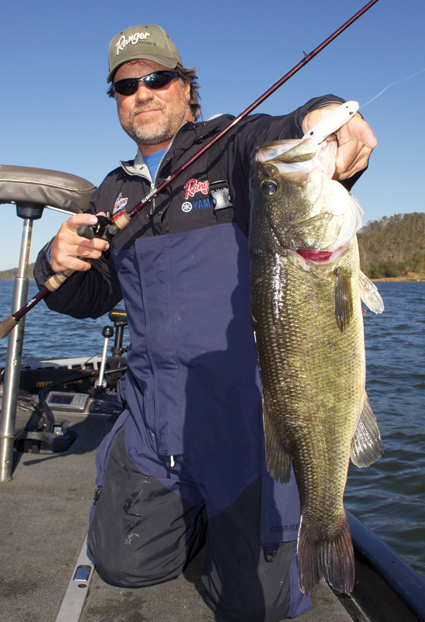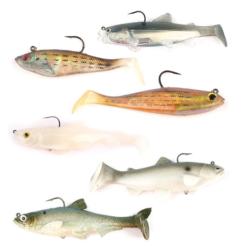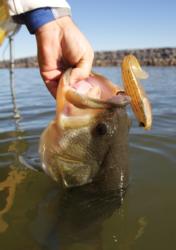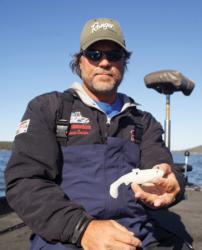The Swimbait Frontier

You’d expect 2006 Forrest Wood Cup champion and National Guard pro Brent Ehrler to unleash a bag of Western swimbait tricks on unsuspecting Southeastern bass occasionally, considering his California pedigree. But when it comes to heavy soft-plastic swimbaits, those rigged with internal lead weights, he’d be the first to admit that he learned a lot of what he knows about them after he came East.
In the last few seasons, “pre-rigged” swimbaits have become part of the rotation of go-to tools for fishing offshore in the shad-rich waters of reservoirs in the Southeast and Midwest. They sink quickly, hold up against repeated attacks by schooling bass and display enough action to draw bites even in murky water.
Fortunately for Ehrler, he’s a fast learner, and the lure has become a regular part of his arsenal. He rarely employs the swimbait as his sole tournament lure in the East, but says that it allows him to “put something different in the rotation” when he has a school of bass pinned on offshore structure.
While California still remains the swimbait epicenter, there’s a reverse flow of information occurring now that goes from east to west. New offshore tactics, particularly with the smaller 5- to 6-inch swimbaits, are being refined on Tennessee Valley Authority lakes and other Eastern impoundments with tremendous results. We asked several top tour pros to weigh in on the subject in preparation for the 2012 season. Here’s what they had to say.
Pre-Rigged Swimbaits
It seems swimbaits come in every size, color and shape imaginable these days. Typically, pre-rigged swimbaits have soft-plastic bodies, internal lead weights and a single large hook protruding out of the back. These aren’t hollow, unrigged swimbaits such as the Strike King Shadalicious, nor are they jumbo slow-sinkers as are used out West. Instead, they’re more like a combination of a soft-plastic swimming body and a lead-head jig. They can vary in size from about 3 inches up to about 9 inches, with 5- to 6-inchers being in the primary range.
 The Berkley Saltwater PowerBait Mullet, Storm WildEye Swim Shad and Osprey Tournament Talon Top Hook are prime examples.
The Berkley Saltwater PowerBait Mullet, Storm WildEye Swim Shad and Osprey Tournament Talon Top Hook are prime examples.
Common denominators include paddle tails that “swim” even on a slow retrieve, the propensity to sink quickly and stay near bottom, and availability in a variety of colors that mimic forage. With regard to the latter feature, our experts generally agree that color is not a huge deal, as long as you’re using something that replicates a shad. In trout-stocked lakes, a rainbow trout replica can also be a killer.
Make it Step 2
While pre-rigged swimbaits are great tools for catching bass from offshore structure, they typically work best when used as a follow-up lure when a school of bass is active and you need a big bite.
“I’ll throw a crankbait and get ’em fired up,” Ehrler says. “But then when they start to slow down, I’ll throw the swimbait and often catch the biggest fish of the bunch.”
Kevin Snider of Elizabethtown, Ky., agrees. He uses a pre-rigged swimbait once he’s pulled a fish or two from a spot. He notes that the technique has to be employed carefully, calling it a “double-edged sword.” It might get you a big bite or two, but it also sometimes “gets the school screwed up and scatters them.” Once scattered, they might not bite again for a while.
Current Analysis
McCalla, Ala., pro and Coosa River expert Kyle Mabrey notes that internally weighted swimbaits are deadly on the spotted bass lakes near his home and on largemouth reservoirs around the country. In both cases, the determining factor in their use involves the current.
“For spotted bass, I usually slow-roll it along the bottom, but you have to let what you see on your graph dictate how you retrieve it,” he says. “At Pickwick last year I was seeing the bass suspended up off the bottom. That happens when there’s an absence of current. It causes them to suspend. Yet when the current is ripping hard you need to keep the swimbait in contact with the bottom, so it’s best to barely urn the handle.”
Ehrler has found the same to be true on reservoirs with current, as opposed to the natural fisheries near his home.
“I fish them differently on places like Kentucky Lake ledges than I do at home,” Ehrler says. “At home, I fish them more like a spinnerbait, while here [in the East] I cast them out and let them sink to the bottom. I usually do best when I’m almost hitting the bottom the whole way.”
 In some instances, a dragging presentation, done either by lifting the rod tip or slowly sweeping it sideways, is required to keep contact with the bottom the entire time. Other times you can slowly retrieve it and occasionally pause to allow the swimbait to fall to bottom.
In some instances, a dragging presentation, done either by lifting the rod tip or slowly sweeping it sideways, is required to keep contact with the bottom the entire time. Other times you can slowly retrieve it and occasionally pause to allow the swimbait to fall to bottom.
Gary Dobyns of Yuba City, Calif., is another swimbait aficionado. He likes to fish a swimbait like a crankbait, with the exception being that he can hit any depth with it. When bass suspend, the trick is to count down the lure to the depth where they are suspending.
“There will be times when you can’t catch them on a jig,” Dobyns explains. “They just won’t bite it, but they’ll jump right on a swimbait if you drag it by them. I think of it as a giant crankbait, but there’s no crankbait you can get to run 25 to 35 feet.”
Some swimbait manufacturers identify the sink rate of their swimbaits on the package. For others, you’ll have to learn it through experimentation. Keep in mind that the type of line (monofilament versus fluorocarbon, for example) and diameter will affect the sink rate, which you might use to alter your presentation slightly.
Seasonal Considerations
 Pre-rigged swimbaits work just about any time of year for offshore bass schooled up on offshore humps, points and drop-offs. In seasons when bass forage in shallower water, lighter swimbaits or hollow, unrigged swimbaits are better options.
Pre-rigged swimbaits work just about any time of year for offshore bass schooled up on offshore humps, points and drop-offs. In seasons when bass forage in shallower water, lighter swimbaits or hollow, unrigged swimbaits are better options.
 “It’s a postspawn bite for me,” Snider says. “It slacks off a bit later in the summer, but I keep it out because you might still use it to catch a couple of big ones.”
“It’s a postspawn bite for me,” Snider says. “It slacks off a bit later in the summer, but I keep it out because you might still use it to catch a couple of big ones.”
Dobyns agrees that the postspawn bite can be good, but in the Golden State there’s a tremendous bite that starts around the first of November, when stocked trout become more active.
“As the weather gets nastier, it [the swimbait bite] just gets better,” he says. “And it goes all the way through the end of April.”
Mabrey employs swimbaits practically year-round. During tournament season he’ll slow-roll a swimbait on ledges on reservoirs, but he’ll also use it in the heart of winter on his favorite Alabama spotted bass lakes.
That’s one of the keys to this style of swimbait for offshore fishing: As long as bass are present and they’re feeding on baitfish, the pre-rigged swimbait, with its sinking presentation and bait-imitating profile, is hard to beat.
… Read more in our March 2012 issue of FLW Bass Fishing magazine.
Editor’s note: This is just a sample of the kind of great content readers will find when they open the pages (or navigate through the online edition) of the March issues of FLW Bass Fishing and FLW Walleye Fishing magazines, both offering many articles to help improve your fishing.